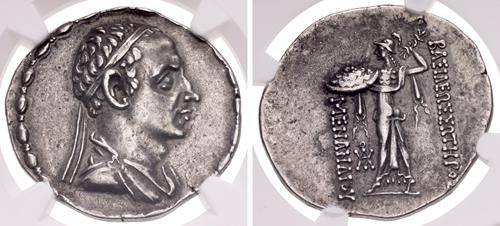|
BAKTRIA, Indo-Greek Kingdom. Menander I Soter. Circa 155-130 BC. AR Tetradrachm (35mm, 16.84 g, 1h). Attic Standard. Diademed and draped bust right within bead-and-reel border / BAΣIΛEYΩΣ ΣΩTHPOΣ to right, MENANΔPOY to left, Athena Alkidemos advancing left, brandishing shield on left arm, decorated with aegis, and thunderbolt in right hand; monogram to inner left. Bopearachchi 11B and pl. 28, A = Bopearachchi, Graeco-Bactrian, 2 = MIG Type 212a = HGC 12, 179 = Leu 13, lot 329 (this coin); Bopearachchi & Rahman –; SNG ANS –. Toned. Spectacular portrait. In NGC encapsulation 2049368-001, graded Ch XF★, Strike: 5/5, Surface: 5/5. Bopearachchi cites only two examples – this coin, and the specimen in the Bibliothèque Nationale, none in CoinArchives.
From the Melinda Collection. Ex Leu 13 (29 April 1975), lot 329 (where it hammered CHF 60,000).
Menander I Soter, known as Melinda in Indian lore, is likely the most famous Greek ruler of the far east, and is the only one whose reign left an indelible imprint on Indian historical traditions. His reign overlapped and extended beyond that of Eukratides I Megas in Baktria, apparently beginning circa 155 BC in the northern Punjab. His was reputedly born near Sagala (modern Sialkot, Pakistan) and later made that city his capital. How he rose to power is unrecorded, but he successfully resisted the efforts of Eukratides to invade and absorb this region in about 150 BC. When Eukratides was assassinated in 145 BC, Menander counter-invaded and seized all of that king’s Indian possessions. Ultimately he ruled a large swath of northern India that extended as far south as the Hindu holy city of Mathura. An enduring tradition paints Menander as a convert to Buddhism, and a long conversation between the king and a Buddhist sage named Nagasena is recorded in a text called the Melinda Panha (”Questions of Melinda”). He is described as “learned, eloquent, wise, and able, and a faithful observer... of all the various acts of devotion and ceremony” required by the faith. “Many were the arts and sciences he knew... as a disputant he was hard to equal, harder still to overcome.” It concludes, “as in wisdom so in strength of body, swiftness, and valour there was found none equal to Milinda in all India. He was rich too, mighty in wealth and prosperity, and the number of his armed hosts knew no end."
The extensive coinage of Menander’s reign is testament to a thriving economy; however, nearly all surviving coins are bilingual issues on the Indo-Greek standard, tetradrachm weight of about 9.9 grams. The full Attic-weight silver tetradrachm offered herein is one of only two recorded specimens on this standard; a third, with a helmeted “heroic” bust, was sold in Triton VI (12 January 2003, lot 537). O. Bopearachchi dates the issue to circa 145 BC, when Menander regained the Baktrian portion of his kingdom previously lost to Eukratides, after the death of that usurper. Bopearachchi posits that the Attic weight coinages of Menander and other Indo-Greek kings were special issues struck for a region that was still accustomed to the old weight coinage, as opposed to the more prevalent, and lighter, Indian standard.
The final winners of all Triton XXV lots will be determined at the live public sale that will be held on 11-12 January 2022. Triton XXV – Session Two – Greek Coinage (Part 2) through Roman Provincial Coinage will be held Tuesday afternoon, 11 January 2022 beginning at 2:00 PM ET.
Winning bids are subject to a 20% buyer's fee for bids placed on this website and 22.50% for all others.
We recognize that our users may have various Internet Browsers and Operating Systems. We like our visitors to have the best possible experience when using our bidding platform. However, we do recognize that it is impossible to develop applications that work identically, efficiently and effectively on all web browsers. The CNG bidding platform supports the latest stable major version and the stable previous version of Mozilla Firefox and Chrome.
|
